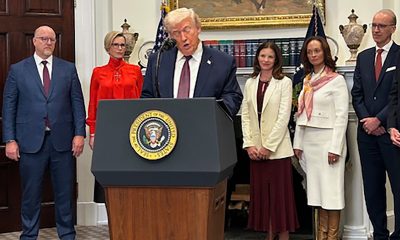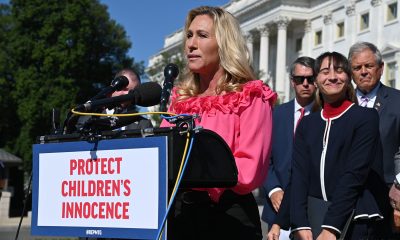National
Supreme Court takes up Prop 8, DOMA cases
Justices to settle two major issues on same-sex marriage
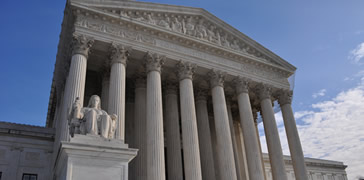
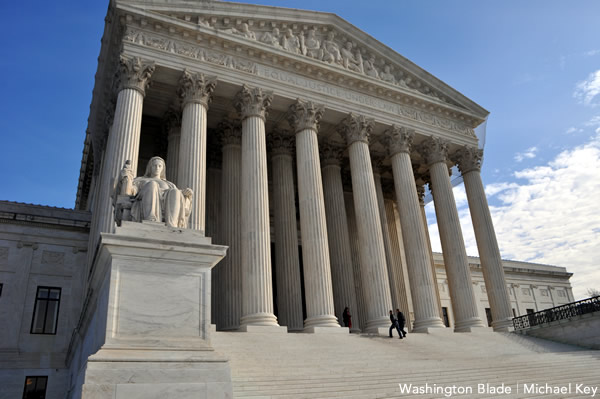
The U.S. Supreme Court took up litigation challenging DOMA and Prop 8 (Washington Blade file photo by Michael Key)
Ending months of anticipation, the U.S. Supreme Court signaled on Friday it would take up litigation challenging California’s Proposition 8 and one case challenging the Defense of Marriage Act.
Justices decided to take up the case of Hollingsworth v. Perry, which seeks to overturn the state constitutional amendment California voters passed in 2008 that took away marriage rights for same-sex couples.
They also decided to take up Windsor v. United States, litigation challenging the constitutionality of the Defense of Marriage Act. That lawsuit was filed by Edith Windsor, a New York widow who was forced to pay $363,000 in estate taxes in 2009 upon the death of her spouse, Thea Spyer.
The court made the news in an orders list published Friday following a conference the justices held on the same day. Four justices must vote affirmatively to grant a writ of certiorari in any particular case, but that vote isn’t public information.
Windsor, 83, expressed excitement in a statement that her lawsuit would be the one to challenge DOMA at the Supreme Court. Her lawsuit was filed by the American Civil Liberties Union along with Paul, Weiss, Rifkind, Wharton & Garrison LLP and other groups.
“When Thea and I met nearly 50 years ago, we never could have dreamed that the story of our life together would be before the Supreme Court as an example of why gay married couples should be treated equally, and not like second-class citizens,” Windsor said. “While Thea is no longer alive, I know how proud she would have been to see this day. The truth is, I never expected any less from my country.”
This news that the court will take up the Perry case is disappointing to many who had hoped justices would decline to hear the litigation and allow a U.S. Ninth Circuit Court of Appeals decision striking down the measure to stand.
John Eastman, chair of the anti-gay National Organization for Marriage, said the decision of the Supreme Court to take up the Prop 8 lawsuit suggests justices are poised to reverse decisions from lower courts against the same-sex marriage ban.
“We believe it is a strong signal that the Court will reverse the lower courts and uphold Proposition 8,” Eastman said. “That is the right outcome based on the law and based on the principle that voters hold the ultimate power over basic policy judgments and their decisions are entitled to respect.”
Still, LGBT advocates expressed excitement that the Supreme Court has decided to take up the Prop 8 case and has the opportunity to rule against California’s same-sex marriage ban once and for all.
Human Rights Campaign President Chad Griffin – who also co-founded the American Foundation for Equal Rights, the organization behind the Prop 8 lawsuit – said the decision marks another “milestone” day for same-sex couples.
“The passage of Proposition 8 caused heartbreak for so many Americans, but today’s announcement gives hope that we will see a landmark Supreme Court ruling for marriage this term,” Griffin said. “As the Court has ruled 14 times in the past, marriage is a fundamental right and I believe they will side with liberty, freedom and equality, moving us toward a more perfect union as they have done in the past.”
The decision means litigation will continue at the Supreme Court and the court will rule on them by the middle of next year. Justices can affirm a Ninth Circuit decision striking down Prop 8 or uphold the anti-gay measure as constitutional. For DOMA, the court could either uphold the federal recognition of same-sex marriage, or strike it down and allow federal benefits to flow to same-sex couples.
No news was made on three other DOMA cases before the Supreme Court: the consolidated case of Gill v. Office of Personnel Management and Massachusetts v. Department of Health & Human Services; Pedersen v. Office of Personnel Management and Golinski v. United States. If justices declined to hear the cases at the Friday conference, it would be announced in another orders list set for publication on Monday.
Doug NeJaime, who’s gay and a professor at Loyola Law School, said justices may have elected to take up the Windsor case — the only DOMA lawsuit in which a federal appeals court ruled against DOMA by applying heightened scrutiny — to apply that same standard to Prop 8.
“If sexual orientation classifications merit heightened scrutiny, as the Second Circuit held, all laws that discriminate against lesbians and gay men – including state marriage prohibitions like Prop. 8 – would be suspect,” NeJaime said.
But NeJaime added taking up both Windsor and Perry may also mean justices see “a material distinction” between a federal law denying recognition to same-sex marriage and a state law preventing same-sex couples from marrying. That could mean the court will split the difference in its rulings, finding DOMA unconstitutional but upholding Prop 8.
In addition to announcing it would take up the litigation, the Supreme Court also asks parties involved in both cases to brief and argue certain questions.
For the Prop 8 case, the parties must answer whether proponents of the same-sex marriage ban have standing under Article III of the U.S. Constitution to defend the same-sex marriage ban in court. Whether anti-gay groups, such as Protect Marriage, have standing to defend the law in court has been a long-standing issue in the case. California Gov. Jerry Brown and California Attorney General Kamala Harris have refused to defend the law in court, leaving anti-gay groups left as the one’s responsible to defend the law.
For the DOMA cases, the court asks parties to answer two questions. The first is whether the executive branch agreement with the U.S. Second Circuit Court of Appeals that DOMA is unconstitutional deprives the Supreme Court of jurisdiction to hear the case. In February 2011, the Obama administration announced that DOMA is unconstitutional and it would no longer defend the law in court.
The second question related to DOMA is whether the House Republican-led Bipartisan Legal Advisory Group has standing to defend the law. After the Obama administration announced it would no longer defend DOMA, House Republicans under the leadership of Speaker John Boehner (R-Ohio) decided to take up defense of the law in the administration’s stead.
The Supreme Court has continually put off making a decision on whether to take up the Prop 8 and DOMA litigation. The cases were first docketed for the conference on Sept. 24, but made no decision at that time. The cases were then docketed for the Nov. 20 conference, but then rescheduled for Nov. 30. No decision was made at that later date. For the recent conference on Nov. 30, it was speculated justices put off making a decision because they needed to more time to decide which combination of the four DOMA cases it wanted to take up.
The next step in the process is for the petitioner — or the party that made an appeal to the Supreme Court — to file opening briefs. Generally, the deadline to do this is 45 days after the court has decided to take up a case. Opposing parties have 30 days to respond, and the petitioner has another 30 days to respond to that. Others parties during this time may also file friend-of-the-court briefs before the court.
Oral arguments will be scheduled by the clerk’s office and likely be announced next week. They’re expected to take place in late Winter or Spring of next year. The court must render a decision before its term ends in June.
No news was also made in another LGBT-related case before the Supreme Court related to Arizona domestic partner benefits. Gov. Jan Brewer appealed to court an injunction barring her from enforcing a law taking away benefits Arizona state employees with same-sex partners. As with the other DOMA cases, if justices have declined to hear the case at the Friday conference, their decision would be announced in another orders list on Monday.
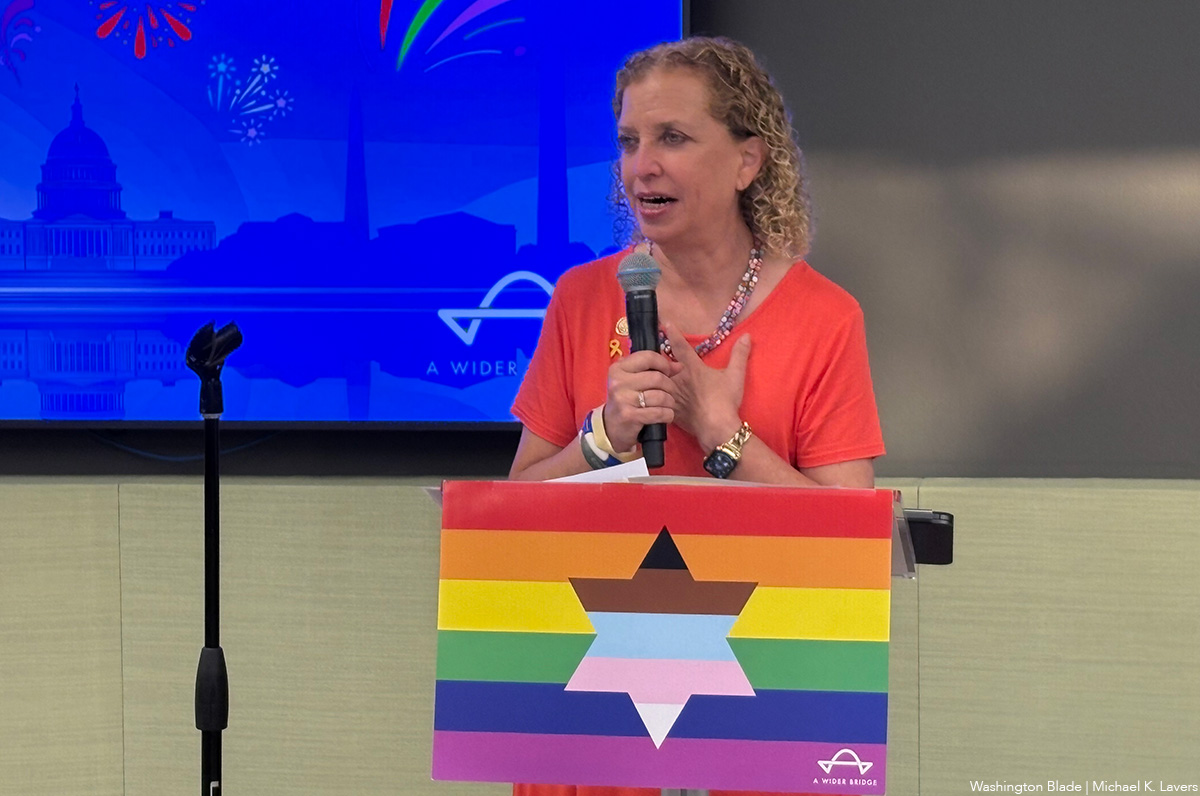
A Wider Bridge on Friday announced it will shut down at the end of the month.
The group that “mobilizes the LGBTQ community to fight antisemitism and support Israel and its LGBTQ community” in a letter to supporters said financial challenges prompted the decision.
“After 15 years of building bridges between LGBTQ communities in North America and Israel, A Wider Bridge has made the difficult decision to wind down operations as of Dec. 31, 2025,” it reads.
“This decision comes after challenging financial realities despite our best efforts to secure sustainable funding. We deeply appreciate our supporters and partners who made this work possible.”
Arthur Slepian founded A Wider Bridge in 2010.
The organization in 2016 organized a reception at the National LGBTQ Task Force’s Creating Change Conference in Chicago that was to have featured to Israeli activists. More than 200 people who protested against A Wider Bridge forced the event’s cancellation.
A Wider Bridge in 2024 urged the Capital Pride Alliance and other Pride organizers to ensure Jewish people can safely participate in their events in response to an increase in antisemitic attacks after Hamas militants attacked Israel on Oct. 7, 2023.
The Jewish Telegraphic Agency reported authorities in Vermont late last year charged Ethan Felson, who was A Wider Bridge’s then-executive director, with lewd and lascivious conduct after alleged sexual misconduct against a museum employee. Rabbi Denise Eger succeeded Felson as A Wider Bridge’s interim executive director.
A Wider Bridge in June honored U.S. Rep. Debbie Wasserman Schultz (D-Fla.) at its Pride event that took place at the Capital Jewish Museum in D.C. The event took place 15 days after a gunman killed two Israeli Embassy employees — Yaron Lischinsky and Sarah Milgrim — as they were leaving an event at the museum.
“Though we are winding down, this is not a time to back down. We recognize the deep importance of our mission and work amid attacks on Jewish people and LGBTQ people – and LGBTQ Jews at the intersection,” said A Wider Bridge in its letter. “Our board members remain committed to showing up in their individual capacities to represent queer Jews across diverse spaces — and we know our partners and supporters will continue to do the same.”
Editor’s note: Washington Blade International News Editor Michael K. Lavers traveled to Israel and Palestine with A Wider Bridge in 2016.
The White House
‘Trump Rx’ plan includes sharp cuts to HIV drug prices
President made announcement on Friday

President Donald Trump met with leaders from some of the world’s largest pharmaceutical companies at the White House on Friday to announce his new “Trump Rx” plan and outline efforts to reduce medication costs for Americans.
During the roughly 47-minute meeting in the Roosevelt Room, Trump detailed his administration’s efforts to cut prescription drug prices and make medications more affordable for U.S. patients.
“Starting next year, American drug prices will come down fast, furious, and will soon be among the lowest in the developed world,” Trump said during the meeting. “For decades, Americans have been forced to pay the highest prices in the world for prescription drugs by far … We will get the lowest price of anyone in the world.”
Trump signed an executive order in May directing his administration “to do everything in its power to slash prescription drug prices for Americans while getting other countries to pay more.”
“This represents the greatest victory for patient affordability in the history of American health care, by far, and every single American will benefit,” he added.
Several pharmaceutical executives stood behind the president during the announcement, including Sanofi CEO Paul Hudson, Novartis CEO Vas Narasimhan, Genentech CEO Ashley Magargee, Boehringer Ingelheim (USA) CEO Jean-Michel Boers, Gilead Sciences CEO Dan O’Day, Bristol Myers Squibb General Counsel Cari Gallman, GSK CEO Emma Walmsley, Merck CEO Robert Davis, and Amgen Executive Vice President Peter Griffith.
Also in attendance were Health and Human Services Secretary Robert F. Kennedy Jr., Commerce Secretary Howard Lutnick, Centers for Medicare and Medicaid Services Administrator Mehmet Oz, and Food and Drug Administration Commissioner Marty Makary.
Under the Trump Rx plan, the administration outlined a series of proposed drug price changes across multiple companies and therapeutic areas. Among them were reductions for Amgen’s cholesterol-lowering drug repatha from $573 to $239; Bristol Myers Squibb’s HIV medication reyataz from $1,449 to $217; Boehringer Ingelheim’s type 2 diabetes medication jentadueto from $525 to $55; Genentech’s flu medication xofluza from $168 to $50; and Gilead Sciences’ hepatitis C medication epclusa from $24,920 to $2,425.
Additional reductions included several GSK inhalers — such as the asthma inhaler advair diskus 500/50, from $265 to $89 — Merck’s diabetes medication januvia from $330 to $100, Novartis’ multiple sclerosis medication mayzent from $9,987 to $1,137, and Sanofi’s blood thinner plavix from $756 to $16. Sanofi insulin products would also be capped at $35 per month’s supply.
These prices, however, would only be available to patients who purchase medications directly through TrumpRx. According to the program’s website, TrumpRx “connects patients directly with the best prices, increasing transparency, and cutting out costly third-party markups.”
Kennedy spoke after Trump, thanking the president for efforts to lower pharmaceutical costs in the U.S., where evidence has shown that drug prices — including both brand-name and generic medications — are nearly 2.78 times higher than prices in comparable countries. According to the Pharmaceutical Research and Manufacturers of America, roughly half of every dollar spent on brand-name drugs goes to entities that play no role in their research, development, or manufacturing.
“This is affordability in action,” Kennedy said. “We are reversing that trend and making sure that Americans can afford to get the life-saving solutions.”
Gilead CEO Dan O’Day also spoke about how the restructuring of drug costs under TrumpRx, combined with emerging technologies, could help reduce HIV transmission — a virus that, if untreated, can progress to AIDS. The LGBTQ community remains disproportionately affected by HIV.
“Thank you, Mr. President — you and the administration,” O’Day said. “I think this objective of achieving the commitment to affordability and future innovation is extraordinary … We just recently launched a new medicine that’s only given twice a year to prevent HIV, and we’re working with Secretary Kennedy and his entire team, as well as the State Department, as a part of your strategy to support ending the epidemic during your term.
“I’ve never been more optimistic about the innovation that exists across these companies and the impact this could have on America’s health and economy,” he added.
Trump interjected, asking, “And that’s working well with HIV?”
“Yes,” O’Day replied.
“It’s a big event,” Trump said.
“It literally prevents HIV almost 100 percent given twice a year,” O’Day responded.
A similar anti-HIV medication is currently prescribed more than injectable form mentioned by O’Day. PrEP, is a medication regimen proven to significantly reduce HIV infection rates for people at high risk. Without insurance, brand-name Truvada can cost roughly $2,000 per month, while a generic version costs about $60 per month.
Even when medication prices are reduced, PrEP access carries additional costs, including clinic and laboratory fees, office visits, required HIV and sexually transmitted infection testing, adherence services and counseling, and outreach to potentially eligible patients and providers.
According to a 2022 study, the annual total cost per person for PrEP — including medication and required clinical and laboratory monitoring — is approximately $12,000 to $13,000 per year.
The TrumpRx federal platform website is now live at TrumpRx.gov, but the program is not slated to begin offering reduced drug prices until January.
The White House
EXCLUSIVE: Democracy Forward files FOIA lawsuit after HHS deadnames Rachel Levine
Trans former assistant health secretary’s name changed on official portrait

Democracy Forward, a national legal organization that works to advance democracy and social progress through litigation, policy and public education, and regulatory engagement, filed a lawsuit Friday in federal court seeking to compel the U.S. Department of Health and Human Services to release information related to the alteration of former Assistant Secretary for Health Adm. Rachel Levine’s official portrait caption.
The lawsuit comes in response to the slow pace of HHS’s handling of multiple Freedom of Information Act requests — requests that federal law requires agencies to respond to within 20 working days. While responses can take longer due to backlogs, high request volumes, or the need for extensive searches or consultations, Democracy Forward says HHS has failed to provide any substantive response.
Democracy Forward’s four unanswered FOIA requests, and the subsequent lawsuit against HHS, come days after someone in the Trump-Vance administration changed Levine’s official portrait in the Hubert H. Humphrey Building to display her deadname — the name she used before transitioning and has not used since 2011.
According to Democracy Forward, HHS “refused to release any records related to its morally wrong and offensive effort to alter former Assistant Secretary for Health Admiral Rachel Levine’s official portrait caption.” Levine was the highest-ranking openly transgender government official in U.S. history and served as assistant secretary for health and as an admiral in the U.S. Public Health Service Commissioned Corps from 2021 to 2025.
Democracy Forward President Skye Perryman spoke about the need to hold the Trump-Vance administration accountable for every official action, especially those that harm some of the most targeted Americans, including trans people.
“The question every American should be asking remains: what is the Trump-Vance administration hiding? For an administration that touts its anti-transgender animus and behavior so publicly, its stonewalling and silence when it comes to the people’s right to see public records about who was behind this decision is deafening,” Perryman said.
“The government’s obligation of transparency doesn’t disappear because the information sought relates to a trailblazing former federal official who is transgender. It’s not complicated — the public is entitled to know who is making decisions — especially decisions that seek to alter facts and reality, erase the identity of a person, and affect the nation’s commitment to civil rights and human dignity.”
“HHS’s refusal to respond to these lawful requests raises more serious concerns about transparency and accountability,” Perryman added. “The public has every right to demand answers — to know who is behind this hateful act — and we are going to court to get them.”
The lawsuit also raises questions about whether the alteration violated federal accuracy and privacy requirements governing Levine’s name, and whether the agency improperly classified the change as an “excepted activity” during a lapse in appropriations. By failing to make any determination or produce any records, Democracy Forward argues, HHS has violated its obligations under federal law.
The case, Democracy Forward Foundation v. U.S. Department of Health and Human Services, was filed in the U.S. District Court for the District of Columbia. The legal team includes Anisha Hindocha, Daniel McGrath, and Robin Thurston.
The Washington Blade reached out to HHS, but has not received any comment.
The lawsuit and four FOIA requests are below:
-

 Politics3 days ago
Politics3 days agoLGBTQ Democrats say they’re ready to fight to win in 2026
-

 District of Columbia2 days ago
District of Columbia2 days agoBrian Footer suspends campaign for Ward 1 D.C. Council seat
-

 Chile5 days ago
Chile5 days agoFar-right José Antonio Kast elected Chile’s next president
-

 Opinions3 days ago
Opinions3 days agoLighting candles in a time of exhaustion

